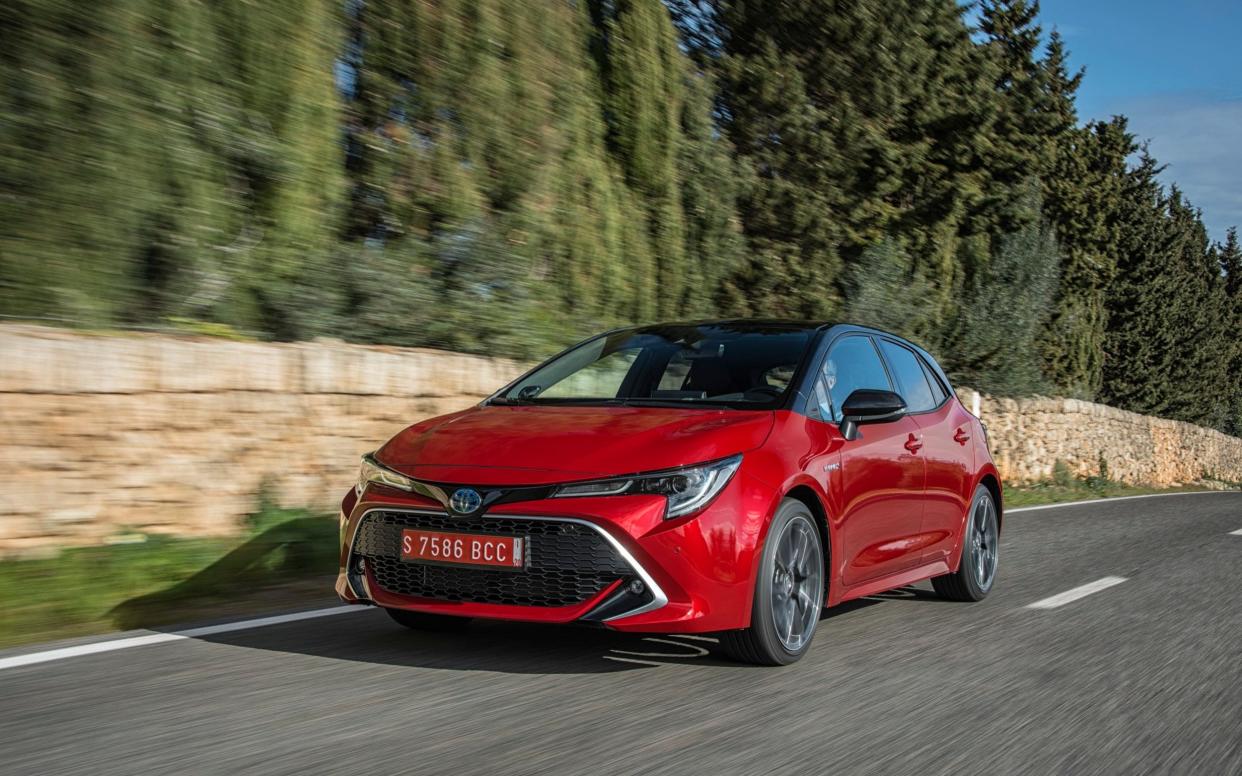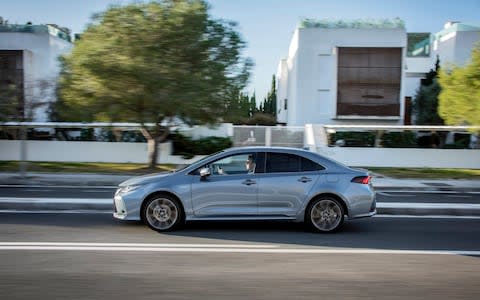Toyota Corolla review: the world's most popular car is back

They say you're never more than 50 metres from a rat. And with more than 46 million sold since 1966, you're probably never too far from a Toyota Corolla either.
After a brief decade-long hiatus, the model returns to the UK. This all-new, 12th-generation version is based the same platform as the Prius, CN-G and RAV4, and as well as the standard hatchback, Toyota is also launching an estate and a saloon, each with a 60mm longer wheelbase.
Wow, a non-premium family saloon! Vauxhall stopped selling its Astra-based Belmont in 1991, Ford’s Escort-based Orion was axed in 1993 and even VW ditched its Golf-with-a-boot Jetta in 2017. So is a Corolla four-door saloon going to work here? I’m not taking bets.
All the cars have a MacPherson-strut front suspension and an independent multi-link rear end, with electronically-assisted rack-and-pinion steering. There are three engine derivatives including two hybrids.
A conventional 112bhp/136lb ft, 1.2-litre, four-cylinder turbo petrol engine provides a top speed of 124mph, 0-62mph in 9.3sec, a WLTP Combined fuel consumption of 47mpg and CO2 emissions of 132g/km (on 17-inch wheels).
The base hybrid is the same as that in the new Prius; a 96bhp/105lb ft 1.8-litre with a total system output of 118bhp and equivalent figures of 112mph, 10.9sec, 66.9mpg and 83g/km. There’s also a harder-revving 150bhp/140lb ft 2.0-litre hybrid producing a total of 176bhp, with equivalent figures of 112mph, 7.9sec, 60.6mpg and 89g/km.

I got ticked off for my last Toyota test, of the new RAV4. Toyota thought I'd been unfair (I wasn't), that no one else thought as I did (they did) and that I'd "put the boot in" (my editor would have my guts if I had). Such flak is part and parcel of the job; it usually means that marketing have spent too much on a television advertising campaign.
Among a current bunch of weird-looking Toyotas, the new Corolla seems to be a meld of the best and most interesting; this is a good looking, coherently designed car with an attractive front panel and mean-looking headlamps. The rear is less memorable and calling the estate a Touring Sports doesn't make it any more exciting.
The saloon body is also handsome if bland, though its falling roofline makes rear-seat access and egress a head-banging struggle, which will restrict its appeal in the minicab market.
The interior presents a high quality facia, with well-located panels covered in pleasant fabrics and an attractive brushed chrome finishing strip. It's tightly assembled, although quality declines as your hands roam lower and higher, and the seat controls are sharp-edged.
The main instruments are clear and concise, although the steering wheel and touchscreen controls take some learning, the centre screen graphics are imprecise and the software often hangs. This is something of a depressing feature of Toyota's latest generation models. The company says it plans to offer Apple Car Play by the end of the year, although it hasn't mentioned Android Auto.

Front-seat accommodation is roomy but the door pockets and centre cubby are small and the seats aren't the most comfortable. In the back it's just possible to get one six footer behind another in the hatchback and there's more room in the estate and saloon.
The rear seats fold 60/40, but only the estate has a flat floor. The boot is 361 litres, which is far from class-leading, although the estate's 598 litres (rising to 1,606 with the seats folded) is plenty big enough. The saloon's boot is 471 litres.
Much of Toyota's safety systems are standard, with a radar- and camera-based pre-collision warning and braking system now able to recognise pedestrians night and day, but cyclists only in daylight. All the cars get a reversing camera, as well as automatic dipping, lane-departure alert, lane-centre steering assistance and road-sign recognition. They also get heated front seats (rear seats, too, on the saloon) and a height-adjustable driver's seat.
Only the two hybrid cars were available to drive. By far the biggest seller will the 1.8-litre hatchback. That engine starts with a minor cacophony of wheezes, whistles and whooshes as it charges the lithium-ion battery - the saloon uses a nickel-metal hydride battery. Performance isn't too bad, but you find your foot is buried to the floor for much of the time and you need a huge run-up to complete an overtake. It's also pretty noisy, with the harsh engine note grinding its way into the cabin, accompanied by a fair bit of wind noise and rumble from the tyres at motorway speeds. It's reasonably economical, though; we achieved almost 48mpg during brisk driving.
The 2.0-litre version is an object lesson in how extra capacity can improve refinement. The extra system torque means the engine does less of a rubber-band impression when you accelerate and unlike the 1.8 there are artificial “gears” for the epicyclic drivetrain which you can change with steering-wheel paddles.

There is also extra sound deadening in the bulkhead and door posts and also an acoustic layer to the windscreen, which calms the cabin at speed. I also thought the 18-inch tyres were quieter and rode better.
This is by far the best powertrain, and you shouldn't pay too much in extra CO2-related taxes, but despite the official figures you could end up paying at the pumps; we achieved only 38.7mpg. The 2.0-litre typically costs another £1,725 over the 1.8 and is only available in the upper trim ranges.
Dynamically the 1.8 hatchback isn't particularly noteworthy. The ride is passably comfortable, but the 17-inch tyres clatter over bumps and it lacks the suppleness of the Golf or Focus on badly patched roads.
The extra weight of the hybrid and its battery doesn't help and although it's an improvement over the Auris and the bodyshell feels stiffer, the handling is competent rather than effervescent. The steering has a dull on-centre response, but it is accurate and well weighted. The brakes, which combine friction and regeneration retardation, are strong but they aren't particularly smooth, especially at low speeds.

Better by far are the longer wheelbase estate and saloon, which have a more balanced chassis response and a calmer ride quality, especially on the 18-inch wheels of the 2.0-litre hybrid driveline. It's a way short of the very best in the class, but the handling is sharp and there's even a bit of fun in there, particularly the way the nose tightens its line if you lift off the accelerator.
If you are after a British-built hatchback, your choice is between the Astra and Corolla. If you want a hybrid drivetrain, then the Corolla stands alone.
Drive long distances on relatively open roads, however, and you'll simply not achieve the hybrid’s claimed fuel consumption.
The Corolla is well short of the best in class dynamically, but it's well built, attractive and some of the models are even pretty good to drive.
Toyota Corolla – facts and specifications
TESTED 1,798cc, four-cylinder petrol engine with twin synchronous 600-volt electric motors and a lithium-ion battery, epicyclic transmission, front-wheel drive
PRICE/ON SALE £21,300 to £30,340 (as tested from £27,340)March
POWER/TORQUE
Engine: 96bhp @ 5,200rpm, 105lb ft @ 3,600rpm
Electric motor: 71bhp/120lb ft
Total system output: 118bhp @ 5,200rpm
TOP SPEED 112mph
ACCELERATION 0-62mph in 10.9sec
FUEL ECONOMY 55-65mpg (WLTP Combined). On test 47.8mpg
CO2 EMISSIONS 83g/km (on 17in wheels)
VED £105 first year, then £140
VERDICT The twelfth version of the world's most popular car name plate is a big improvement over the Auris it replaces. It's good looking and the tax benefits of the mainly hybrid range are undeniable, but you won't achieve the claimed fuel savings unless you drive a lot in town. Also, rivals are streets ahead dynamically.
TELEGRAPH RATING Four out of five stars
Toyota Corolla – main rivals
Volkswagen Golf, from £17,785
Things get pretty expensive pretty quickly in the Golf brochure, but the fact is that it is Europe's bestselling car with good reason. The 1.5-litre turbo petrol suits the size and weight well and the DSG gearbox is (now) smooth and reliable.
Ford Focus, from £18,300
The latest Focus is one of the standout cars of its class with a sparkling update on cabin design, lots of space and unrivalled ride and handling (provided you buy the more expensive independent suspension). No plug-in hybrid as yet, but we're expecting one soon.
Vauxhall Astra, from £18,350
Carving almost 100kg out of the Astra for its last revision proved that there was a good car under the skin all along. Lithe and brisk, the 1.4-litre is a terrific driving machine with a great ride quality. Along with the Corolla, it is one of the last British-built family hatchbacks.
Kia Ceed, from £17,480
All new last year, this third generation of the Ceed is well built, with a stiff bodyshell and independent rear suspension across the range. The engines are throaty, though, the twin-clutch semi-auto gearbox isn't the smoothest, nor is the cabin the last word in design and taste. A seven-year warranty persuades a lot of buyers, however.
For tips and advice, visit our Advice section, or sign up to our newsletter here
To talk all things motoring with the Telegraph Cars team join the Telegraph Motoring Club Facebook group here


